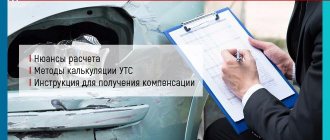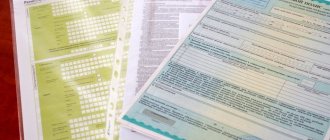Most CASCO insurers do not fully know the terms of their contract, and are not sure whether UT is included in their insurance contract or not. Typically, insurance companies do not pay insurance claims under the insurance policy, interpreting the insurance contract in their favor. CASCO insurance – loss of marketable value.
In such cases, according to the decision of the Supreme Court of the Russian Federation, insurers are obliged to pay such payments. The judge, in this case, relies on the fact that the insurance policy directly relates to the insured event, since this is specified in the insurance contract and is interpreted as damage to the car.
What is UTS?
To find out what CTS is, you just need to read its decoding.
LTS – loss of marketable value. Means damage to parts, protective surfaces, replacement of joints and other parts associated with the vehicle obtained during repairs or a traffic accident, as a result of which the car loses its appearance or marketable value.
A similar definition was indicated in the resolution of the Supreme Court of the Russian Federation dated July 24, 2007. No. GKPI07-658. This resolution designates damage that is classified as insured incidents.
Explained in simple words, the loss of marketable value is a decrease in the quality of the vehicle, as well as its appearance.
In the event of a decrease in the market value of the car, as well as in the event of an accident or the absence of the culprit, the court invites the insurance company to include calculations for vehicle insurance in its payments under the CASCO policy.
Typically, lawyers work under the following articles: clause 2 of article 15, clause 2 of article 12 of the Federal Law “On compulsory motor liability insurance for vehicle owners”, as well as article 929 of the Civil Code, after reading which you can understand that vehicle insurance is real damage, which in must be calculated and included in insurance payments.
The compulsory insurance contract is concluded in relation to the owner of the vehicle, the persons specified by him in the compulsory insurance contract, or in relation to an unlimited number of persons allowed by the owner to drive the vehicle in accordance with the terms of the compulsory insurance contract, as well as other persons using the vehicle legally basis.
clause 2 of article 15 of the Federal Law “On compulsory motor vehicle liability insurance for vehicle owners”
The insurance payment due to the victim for causing harm to his health as a result of a traffic accident is carried out in accordance with this Federal Law to compensate for the costs associated with restoring the victim’s health and his lost earnings (income) in connection with causing harm to health as a result of traffic accident.
Insurance payment for personal injury in terms of reimbursement of necessary expenses for restoring the victim’s health is carried out by the insurer on the basis of documents issued by authorized police officers and confirming the fact of a road traffic accident, and medical documents provided by medical organizations that provided medical assistance to the victim in connection with with the insured event, indicating the nature and extent of damage to the victim’s health. The amount of the insurance payment in terms of compensation for the necessary expenses for restoring the victim’s health is determined in accordance with the standards and in the manner established by the Government of the Russian Federation, depending on the nature and extent of damage to the victim’s health within the limits of the insurance amount established by subparagraph “a” of Article 7 of this Federal Law law. Information about the insurance policy number and the name of the insurer who insured the civil liability of the owner of the vehicle at fault in a traffic accident is provided to the pedestrian injured in such a traffic accident, or his representative on the day of contacting the police department, whose employees drew up documents about such traffic accident.
clause 2 of article 12 of the Federal Law “On compulsory motor liability insurance for vehicle owners”
Legal consultation
Get qualified help right now! Our lawyers will advise you on any issues out of turn!
To get a consultation
1. Under a property insurance contract, one party (the insurer) undertakes, for the payment stipulated by the contract (insurance premium), upon the occurrence of an event (insured event) provided for in the contract, to compensate the other party (the policyholder) or another person in whose favor the contract was concluded (the beneficiary) for the damage caused as a result of this event, losses in the insured property or losses in connection with other property interests of the insured (pay insurance compensation) within the limits of the amount specified in the contract (insurance amount).
2. Under a property insurance contract, in particular, the following property interests can be insured: 1) the risk of loss (destruction), shortage or damage to certain property (Article 930); 2) the risk of liability for obligations arising from causing harm to the life, health or property of other persons, and in cases provided for by law, also liability under contracts - the risk of civil liability (Articles 931 and 932); 3) the risk of losses from business activities due to violation of their obligations by the entrepreneur’s counterparties or changes in the conditions of this activity due to circumstances beyond the control of the entrepreneur, including the risk of not receiving expected income - business risk (Article 933).
Civil Code of the Russian Federation Article 929. Property insurance contract
In what cases is it legal to collect vehicle insurance under CASCO insurance?
Unfortunately, not every injured driver has the right to receive compensation in this category; moreover, it is quite difficult to find an insurance company that is willing to work with the possibility of paying out the vehicle insurance.
First of all, it should be taken into account that TCB is practiced in the following cases:
1Damage to the vehicle in an accident, as well as other circumstances associated with disasters, falling trees, accidental fires that somehow damaged the car.
2A foreign-made vehicle must be in operation for no more than 5 years.
3Vehicles of a domestic manufacturer must be no older than three years.
4Depreciation of the vehicle is no more than 35% for cars of a domestic manufacturer, and no more than 40% for cars of a foreign manufacturer.
5The mileage of a domestic car should not exceed 50,000 km; for a foreign car, the value may be close to 100,000 km.
6The car does not need to undergo repairs of the first degree of complexity.
7Damage to the car is not considered an insured event.
8 As a result of repairs, the car suffered some damage or lost its original appearance.
At the same time, the main legal factor that influences the insurance company when making a decision on the payment of TTS is a court ruling.
Without resorting to a lawsuit, the insurance company will refuse to pay the insurance policy for a very long time, relying only on the insurance contract and the clauses specified in it.
How is the amount of compensation calculated?
TCB is a calculated value. To determine it, two methods are used:
- Halbgewax method.
- Methodological recommendations of the Ministry of Justice of the Russian Federation.
Calculations using the Halbgewachs method are simple. Using it, you can determine the amount of lost value using the following formula:
UTS = (K:100)*(Tsr+Sr)
Where:
- K is a coefficient determined from the Halbgewax tables and establishing the amount of lost commodity value;
- CR is the market price of the car at the time of the accident, taking into account wear and tear;
- Wed is the cost of car restoration work.
Calculations using the methods of the Ministry of Justice are more complex and more accurate. Damage in this case is determined as a percentage of the value of the vehicle before the accident and is calculated using the following formula:
Suts = C x ∑ Ki/100%
Where:
- C – the valuation of the car in rubles at the time of the accident;
- Ki is a coefficient that takes into account all the necessary repair actions on the car. To determine it, special tables approved by the Ministry of Justice in the annex to the calculation methodology are used.
Compensation for vehicle insurance under CASCO for repair work at a service station
After an accident or necessary repairs, according to the insurance contract, only its performance characteristics will be returned to the car, there is no talk of compensation for property value.
Such compensation is possible only for certain types of repair work:
1When changing or resuming the old body shape and geometry after it has been sufficiently damaged.
2Full or partial replacement of attached body parts.
3Repair of removable and non-removable body parts.
4Full or partial painting of parts or specific parts of the body, as well as work on painting non-metallic parts (tuning elements, car decorations).
5Damage to the factory assembly of the vehicle as a result of disassembly for the purpose of major repairs or painting.
As practice shows, these works can significantly reduce the marketability of the car; therefore, these works are intended primarily for cars after an accident.
After all, as you know, a car that has not yet been in an accident, but has already been subject to one of the above-described cases more than once, also falls under the terms of settlements under the vehicle insurance policy.
Obtaining the necessary documents
Experts in the field of auto insurance advise not to remain idle in cases where your car no longer meets the requirements of vehicle insurance claims. You will never receive insurance payments just like that until you want to do it yourself.
To prepare all the necessary documents, you must remember that you need to be quite decisive with the insurance company, and also prepare certain documents.
First of all, familiarize yourself with the algorithm that was prepared for such cases:
1First of all, write a statement to your insurance company in order to reimburse the vehicle's vehicle. You should contact the company that issued you the CASCO policy. The application must be submitted in two copies, after which you must ensure that they are registered.
2Be sure to contact an expert and independent appraiser in order to be able to establish the cause and the size of your TCB. An independent adjuster is necessary to ensure that all damages are assessed in full, however, if your insurance company works honestly and you trust it, you may not spend money on an independent expert.
3 Do not forget to file a lawsuit in which you indicate your claims against the insurance company in the event that the latter refuses to pay under the TTS. Your application will be considered as a claim if you do not indicate abbreviations from the following laws: clause 2 of article 15, clause 2 of article 12 of the Federal Law “On compulsory motor liability insurance for vehicle owners”, as well as article 1082 of the Civil Code of Russia.
4Prepare your CASCO insurance policy.
5 Documents proving that the car belongs to you. As evidence, it will be enough to provide a driver’s license and documents for the car, or a written and certified power of attorney from the owner of the car.
6Documentation from the master or service station, which will indicate all the necessary parts and their cost. In addition, the work order must indicate the full cost of repairs.
7Add a certificate in form No. 154 (a sample is available below the list), which will be issued by your insurer after you, together with the insurance company, have submitted an application for compensation for vehicle insurance.
8 In case of repair of your vehicle after an accident, be sure to provide the assessment commission with repeated copies of all certificates provided by the traffic police. In addition, you can simply scan all documents and certificates, after which it will be much easier to reproduce them.
Satisfying the claim for compensation for damage, the court, in accordance with the circumstances of the case, obliges the person responsible for causing the damage to compensate for the damage in kind (provide an item of the same kind and quality, correct the damaged item, etc.) or compensate for the losses caused (clause 2 of Article 15). It is worth paying attention to a rather important fact that the loss of the marketable value of a car under CASCO in 2021 is all the damage that the car receives and that was not done intentionally by any party. If your vehicle was intentionally damaged, then the TTS will not be collected.
Civil Code of the Russian Federation Article 1082. Methods of compensation for harm
What are the subtleties of calculation?
At the moment, in our country there are several methods of calculation to compensate for the TCB. The authors of one of the methods are the Central Bank of the Russian Federation. Their methodology is based on the law on compulsory motor liability insurance, and specifically Article 12.1 clause 3. There are also methods of the Ministry of Justice and Halbgewax. The disadvantage of the method is that it is focused only on foreign cars.
To calculate compensation for vehicle insurance using the Halbgewax method, the following data is required: the age of the car, the price of parts, repair costs and labor costs. First of all, the cost of the car on the market is taken and divided by the cost of a completely new car, the result obtained is multiplied by 100% and if the answer is less than 40%, then it makes no sense to calculate the vehicle price.
The calculation of the TTC by the method of the Ministry of Justice has been used since immemorial 2013. Nowadays, it is relevant only in court proceedings, if it comes to conducting an examination. The goal is to determine the cost of car repairs and in the assessment of the vehicle. The object of study is the machine or data provided by the owner. According to this methodology, the amount of LTV (loss of marketable value) will be directly proportional to the type of damage and its characteristics.
And finally, the method developed by the Central Bank of the Russian Federation. This method also has its own subtleties and nuances of calculation. The authors of this technique proposed special rules for determining how to photograph a car; there are certain rules for photographing a car and many other information.
Compensation for technical assistance, judicial practice
Oddly enough, judicial practice in relation to cases of compensation for vehicle insurance is quite constant and most cases are won in favor of the insurers. Unfortunately, the methods for resolving claims are quite straightforward, but they are still effective, which undoubtedly pleases the insured.
The review of the Presidium of the Supreme Court of Russia has the last word in favor of the insured persons. In which it is indicated that the loss of marketable value is in fact real damage, and in this case it is necessary to carry out penalties.
In this regard, the majority of insurance companies decided to include compensation for TC in the list of items for compensation for damage received, since often the fees for lawyers and the costs of judicial bureaucracy significantly exceed the costs of compensation for TC.
Features of the application
Design in a free style, since the law does not provide for a form. The application states the following: in the header of the document you must indicate your passport details, mobile phone number and email. The text of the application must indicate the events in which the car was damaged (accident, someone damaged it, and so on). At the bottom of the document you must indicate where you need to transfer the money (bank card number, etc.), the date on which the application was submitted and do not forget the signature.











